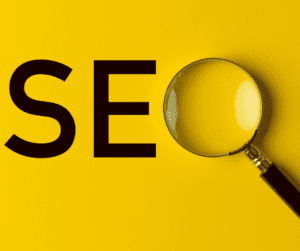Many believe using SEO (Search Engine Optimisation) as a digital marketing tool is no longer necessary; this couldn’t be further from the truth. Did you know that 68% of online experiences start with a search engine? And 80% of purchases begin with online research before the customer has even bought the product? To date, Google has 92.47% of the search engine market share and as of April 2021, it had already received 360 billion searches from this year alone. With these numbers, it’s hard to believe that SEO is going anywhere. Have you thought about the amount of effort you’re putting into your SEO? Do you know if the right people are finding you online and, if not, do you know how to improve your search rankings? An extraordinary 75% of people don’t scroll past the first page of a search engine. So, if you’re not first, you’re last.
In this blog, we’ll unpack exactly what SEO is, how it works and what small businesses can do to improve search rankings without breaking the bank.
SEO (Search Engine Optimisation) is the process of determining how high your website will rank on search engines. It cultivates high-quality traffic to your optimised website to help you rank organically. The higher up your website or content appears, the more attention it will receive from the audience.

When people are searching for information, they go online. So, Google, and search engines alike, favour high-quality, relevant content that is fully optimised, to make the information as easily accessible to the user as possible.
Search engines use a tool called a “crawler”. The best way to think of them is like little search engine spies. The crawler heads out into the internet and collects all the information it can about your content. They collect information like:
The crawler brings back all the data to the search engine to start building an index. The index is then fed through an algorithm to see if the data is premium quality and relevant enough to serve to an audience. When a crawler sees how user-friendly your content is, it will rank it higher. Search engines are happy when search results yield the best results for a user.

There is no quick fix for SEO. A lot of time, patience, trial and error is required. Luckily for you, our team has put together these 8 ways on how to improve your SEO ranking.
We spoke about the importance of this in our previous blog (insert blog link) and so we’d like to remind you once again. Having a slow page loading speed will have a direct impact on how the user engages and interacts with your content. Research has shown that 2 seconds is considered the acceptable amount of time to wait for a page to load and more than 40% of users will abandon your site if your page takes longer than 3 seconds.
If your page has a fast-loading time, people will hang around for longer and keep coming back. The search engines will recognise this and will favour your content.
Unsure how to test your page speed? Here are a few tools to help:
Constantly and consistently work at improving your content to keep it fresh and exciting for the audience and to meet Google’s EAT (expertise, authoritativeness, and trustworthiness) criteria. This will drive more traffic to your website and keep the user engaged and interested. The more high-quality content you provide, the longer the user will spend on your site which has a positive impact on your dwell time.

Dwell time is exactly how it sounds. The time users spend viewing your content after clicking on a link. How do you improve your dwell time? Include video content. Video encourages the user to hover on your page and provide information that is far easier to absorb than written text. We will touch on this a bit later, so keep reading!
You need to make sure your website is properly formatted to ensure user-friendliness. Spend some time making sure that it is clear, organised and is easy for the audience to read. Stay consistent with your fonts and colours and make sure it isn’t cluttered with too many ads, pictures and poorly spaced text. Use things such as headings, subheadings and bullet points to make it easier for the visitor to browse through.

We know this may sound obvious, but it’s unbelievable how many companies don’t include relevant contact information on their page. Add as much information as possible including all phone numbers, email addresses and locations. Not including contact information makes your page seem untrustworthy and can have an incredibly damaging effect on your SEO ranking.
This is probably one of the most important ways you can get your content to the top of that search engine page. If you’re not optimising your on-page SEO, then you can kiss that first-page goal goodbye!
Here is how you can guarantee a fully optimised on-page SEO.
Add well-researched keywords
When people go onto search engines they type in a word or phrase to describe what they are looking for. These are called keywords. Adding relevant keywords to your content helps the search engines to better understand your content and serve it to the user. No keywords = no way for the crawler to figure out what your content is about.
Here are our tips for adding keywords into your content:

Optimise your images
Images that have a big file size will slow down your page loading speed and we’ve already discussed the importance of that. Make sure your images are resized or compressed before adding them to your site.
Use header tags
Instead of having long paragraphs of text, break the content up to create more structure and make it easier to read. Breaking up your text with header tags will encourage people to spend more time on your content instead of becoming overwhelmed and leaving your site.
Use appropriate links
Use outbound and inbound links to increase the credibility and trustworthiness of your website. Search engines will recognise this and rank your site accordingly. Make sure your internal links make use of anchor text and never use more external than internal links in your content.
Write show-shopping titles and descriptions
Write copy that is irresistible and makes people want to click on your link. Users will generally only read the first 3 words of your title, so you need to make sure your title and description are attention-grabbing. Include your keywords, keep it short, clear and try to evoke some emotion from the audience.
Optimise your URL
There is no need for a lengthy URL that is hard to remember. Make sure your URL is relevant to your website, that it is kept short, and it includes your primary keyword.
There is more to content than just text. Include a variety of multimedia elements to create a positive, captivating user experience that keeps people on your site.

Include elements such as video, webinars, infographics, presentations, audio, and podcasts.
This will radically improve how much time someone is spending on your content and depending on the duration of your multimedia content, they could be there for a while.
If you can get that right, the search engines will undoubtedly love you more!
If you don’t already have one, it’s time to start. Companies who blog produce 67% more leads per month and updating blog posts can increase traffic by 106%. As mentioned earlier, producing updated content that is fresh and exciting helps keep people lingering on your page, and blogs are a fantastic way to accomplish this.
Blogs are also an excellent tool for lead generation and optimising your blogs through platforms like Yoast, makes it easier for people to find your site. The more valuable traffic that is being directed to your site, the higher the search engines will rank you organically.

We’ve said it multiple times before and we’ll say it again. Optimising your site for mobile is non-negotiable, especially when it comes to SEO. Mobile usage has overtaken desktops and it’s rising faster than ever imagined. With over 60% of Google searches coming from mobile devices and 74% of users more likely to return to a mobile-friendly site, it’s a no-brainer that the search engines will favour mobile optimised sites.
Every business needs a social media presence whether it’s on all platforms or just a few. Social media is a powerful tool for lead generation, encouraging shareable content and generating more traffic to your website.
The search engine crawlers pay extra attention to social media accounts to see how credible and authentic your brand is which is then fed into their algorithms. The more engagement, interaction and following on your social media, the more your search ranking will improve.
Tip: Make sure to include your social media icons on your website and encourage people to share your blogs on their social media profiles.

SEO may seem daunting if you’re not sure where to begin. But after reading this we hope you feel well equipped to get out there and create a website that is well optimised and full of tantalising, shareable content that leaves your audience coming back for more. With these tips, we have no doubt we will find you on the first page of Google. See you there!